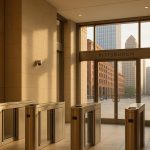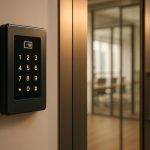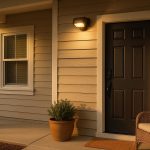Access control and surveillance systems serve distinct roles in security but work best when integrated. Access control manages who can enter specific areas using methods like keycards or biometrics, while surveillance monitors and records activities using cameras. Together, they create a layered security approach – preventing unauthorized access and documenting events for review.
Key Insights:
- Access control: Restricts entry, logs attempts, and allows real-time management of who goes where.
- Surveillance: Records activities, deters potential threats, and provides evidence when needed.
- Integration benefits: Combines access logs with video footage for faster responses and streamlined management.
For Pittsburgh businesses, combining these systems is particularly useful in older buildings with unique architectural challenges. Professionals like Sherlock’s Locksmith offer tailored solutions, ensuring both systems work smoothly together.
Quick Comparison:
| Feature | Access Control | Surveillance |
|---|---|---|
| Primary Purpose | Restrict and log entry | Monitor and record activities |
| Main Tools | Keycards, PINs, biometrics | Cameras, motion sensors |
| Real-time Alerts | Yes | Sometimes (with smart features) |
| Evidence Collection | Limited | High |
| Integration Benefits | Links access logs to video footage | Enhances incident response |
Combining these tools ensures tighter security, faster responses, and easier management – all critical for safeguarding your property.
4.1. Access control systems integration
Entry Watch: How They Work and When to Use Them
Entry watch systems check who a person is and see if they can go into a place. It starts when a person shows their pass – like a keycard or a finger scan – to a reader. This reader takes this info and passes it to a control box, which looks it up on a list of okay users kept on a server. If the check is okay, the door opens for a short time. Each try, hit or miss, is written down.
A big plus of these systems is they keep close tabs on who comes and goes, important for looking into issues. Not like old keys that one can copy or lose, entry watches keep tight records of who got in and when. With over half of break-ins happening when bad folks get into off-limits spots, it’s clear why these setups are needed. These records also work well with cameras, adding more safety.
Entry watches also let you set who can go where, and when. You might let cleaning folks in only at night, but let bosses come and go any time. If someone quits or loses their pass, you can stop their entry right away – no need to change locks.
Here’s what makes these systems tick.
Main Bits of Entry Watch Systems
An entry watch system has some core parts:
- Server: Holds user info and logs what happens. It can be kept in place or on the net.
- Passes: Things like PINs, RFID keycards, fobs, finger scans, or apps that users show to prove who they are.
- Reader: The part that checks the pass, changes it into data, and sends it to the control box.
- Control Box: Makes the call, looking at data from the reader and the list of okay users, telling the lock to open or stay shut.
- Door Locks: These are powered strikes, magnet locks, or powered handles that open when given the okay.
More parts can add more to what it can do:
- Door Position Light (DPL): Checks if the door is open or shut and can buzz if a door is not closed right.
- Out Button (OB): A button or sensor that lets people out safely and tells the system if it’s a normal exit or a forced one.
The system is run by entry control software, letting bosses add users, set rules, and look at logs. Field panels handle day-to-day work and help if the main server stops.
These parts work hand in hand to shape entry setups that fit a mix of needs. Let’s see some usual ways to use entry watch.
In office places, doors let in only those who should be there based on their jobs. Guests might get to wait in the front room during work hours, while special places like the computer rooms are just for IT folks. These setups mix well with watch tools, making them a top pick when making a place more safe.
Places where they make stuff often link door control with time checks to keep risky tools safe and to look at how long workers are there. These two uses make things safer and quicker.
Health spots depend on door control to keep patient info safe and watch over drugs. Hospitals often let only docs and nurses into where patients are, while only picked staff can get into where drugs are kept. The deep records these tools make are also useful for meeting set rules.
For firms in Pittsburgh, door control is key in old buildings where keeping up old safety ways can be hard. Web-based systems make it easy to run things from afar, removing the need for IT folks to be there to fix or set access.
Watch Tools: What They Do and How They Help
Watch systems keep an eye on your area, record what happens and let you see spaces when you’re not there. Unlike door control systems, which pick who gets into a place, watching focuses on tracking doings and spotting issues early on.
These setups keep video and sound recording all the time, catching all when things look odd. This video can be key proof and works to keep bad acts away. By noting what goes on after someone gets in, watch systems help door control give a full safe view.
New watch tools go more by using clever add-ons. They can send notes to your phone if they spot moves, point out new faces, and even tell if it’s a person or a cat that’s moving. With these smart looks, you get alerts for real risks, not just for every strong wind or squirrel that runs by.
When you mix it with door control data, watching gives things’ owners a full look at what’s happening on-site. This mix makes a full safe net, super good in old Pittsburgh places with hidden spots or many ways in that could be weak otherwise.
Key Bits of Watch Systems
To use a watch system well, you should know its main bits:
- Cameras: These are the system’s eyes. Inside cameras mix in with their spots, while outside cameras last through Pittsburgh’s wild weather. Some cameras can move and zoom to follow moves, while others stay still but see wide areas with clear lenses.
- Recording gear: This holds all the video. Digital video recorders (DVRs) pair with old cameras, while network video recorders (NVRs) work with web cameras that link over the net. How much video you can keep – from weeks to months – depends on storage size and video look.
- Watching software: This is the control hub. It lets you watch live, look through old video, and set up alerts. You can use it on a computer or via an app, making it easy to check your area from anywhere.
- Motion catchers: These spot moves and can start recording or send alerts. They’re great in spots where you don’t always need video but need to know about moves. Clever sensors can tell small moves, like a curtain moving, from big ones, like a person walking around.
- Storage tools: Videos need safe keeping. Local keeping holds video on-site, while cloud keeping saves it on far-off servers. Many setups use both – local for quick reach and cloud for backup if gear fails.
- Net links: This joins everything. While wired links are most sure, wireless options are good for spots where putting wires is hard or costly.
How Work Places and Homes Use Watch Systems
Watching systems give live warnings and saved clips, and are key for looking into what happened. Shop bosses can watch their stores in busy times, check staff follow rules, or see who is at the door before letting them in. For insurance, video proof is often needed, and cops use clear videos to look into break-ins or other wrongs. Good video with dates can help catch a bad guy or leave you with no clues.
Watching property lines is also key. Cameras at parking spots, loading areas, and fences can spot bad guys early, giving guards or cops more time to act. This forward-looking way stops bad things before they grow.
In Pittsburgh, shops often use cameras to watch risky spots like cash desks, stock rooms, and tool storage. Eateries watch kitchens for safe food, while stores keep an eye on cash desks and goods shelves where stealing happens most.
Watching from afar changes the game for owners with more than one spot. They don’t need to drive around; they can see live video on their phone or tablet, saving time and fixing problems fast – be it a lost package or a customer needing help.
For home owners, watching systems add more safety. Parents can make sure their kids got home safe from school, and travelers can look at their home while away. In many parts of Pittsburgh, these setups are now a usual part of keeping homes safe, more so when mixed with ways to control who can enter for a fuller safety setup.
How to Link Up Access Control and Watch Systems
Putting access control with watch systems gives security that sends alerts fast, can act quickly, and keeps an eye out well. This join not just ups security but also makes it easy to run.
Steps to Link Both Systems
First, make sure both systems can work with each other. Look for open makes and common types like ONVIF for cameras or OSDP for access control kits.
Then, set up a strong network base. It’s best if both systems use the same network, linked by wired Ethernet or a good wireless set. In places like Pittsburgh, where putting in new wires in big buildings is tough, a good wireless network may work well.
Hook the access control boards and video players to the same network using the right switches or by making the network better as needed. Make sure your network can take on the extra video loads without slow-downs or stops.
Mix the software so the systems run smooth together. For example, set the access control to pull up the right camera view when a card is swiped. This is done through APIs, which let different programs share data right away.
Lastly, fix user rules to control who can see what. For example, the bosses might see all live views, saved clips, and system settings, while front-desk people might just see live views.
Why Linking Systems is Smart
When access control and watch systems are linked, they give perks that go past what they can do alone. A key plus is one-place management – all can be run from one spot, no need to flip between many programs. For example, if someone tries to enter a no-go zone, you can see their info and live video at once, which makes responding faster.
This join also makes security better when things go wrong. If a no-permit entry try is caught, the system shows the right video at once and tells security folks. This lets them act fast and together. Also, the data shared between systems makes reports better and helps track how people move and make a full digital log for looking into things.
On the work side, mixed systems make care easy. Updates and teaching can be run from one spot, which cuts costs over time and makes keeping the system up easier.
Sorting Out Common Link Problems
While mixing systems has many pluses, it’s not without issues. Here are some usual troubles and how to fix them:
- Old Tech: Some old systems with line links may need change gear to connect old and new tech.
- Net Load: Check if your net gear and width can take more load from extra video feeds.
- Clock Sync: Gear on different times can mix up logs and videos. Using net time servers makes sure all gear stays in time.
- Talk Between Apps: Tools from different makers might not talk well. Middle gear can help these work as one.
- Save Space: Be sure you have enough room – on-site or online – to keep all video and logs.
- Power Sure: If main parts lose power, all could stop. Power safety gear is key to keep important gear on when power cuts.
sbb-itb-643e28e
Solo or Joined Systems: Which Is Best
Choosing between solo and joined security systems comes down to what you need and your future plans. Each type has its own give and take, so knowing these differences is important to keep your place safe.
At heart, this choice is about getting the right mix of easy use and full features.
Good and Bad of Each Choice
Here’s a deeper look at what each system gives:
- Solo Systems
- Work on their own, so if one breaks, the others still work fine.
- Let you add new parts slowly, which is great for small sites or if money is tight.
- But, handling many systems can be hard, making steady work and watching harder.
- Joined Systems
- Mix control and watching into one, big system, making it simpler to watch and make smart choices.
- Mixing systems can be hard, especially with old ones or making sure all parts work well together. Set rules are needed to stop mix-ups.
- Need good online safety to keep the whole network safe from dangers.
What you pick often rests on how big and tricky your setup is. Small or slowly growing places might like solo systems more. On the other hand, big, busy spots might do better with joined systems – if mix issues are fixed and safety steps are there. These points also link back to wider plans on setting up and keeping systems, which we’ll look at more in the next part.
How to Set Up and Maintain Security Systems Properly
Getting your security system installed correctly from the start can save you both time and money. Whether you’re setting up access control, surveillance cameras, or a combination of both, success depends on careful planning and ongoing maintenance. These steps ensure your property stays well-protected.
Planning and Installation Tips
Start with a thorough site inspection. Identify all entry points, power sources, structural barriers, and network coverage areas.
Plan your budget realistically. Beyond the cost of equipment, factor in hidden expenses like wiring, permits, and installation. A good rule of thumb is to add 20-30% to the equipment’s price to cover these extras.
Select equipment that supports standard protocols, such as ONVIF or Wiegand, for better integration. For example, you can set up a system where cameras automatically start recording when someone enters.
Check if your network can handle the system’s requirements. For surveillance, allocate between 2-8 Mbps per camera and ensure you have enough bandwidth for smooth overall operations.
How to Keep Systems Running Well
Regular maintenance is essential to ensure your system performs as expected. Here’s how to stay on top of it:
- Software Updates: Update system software every three months. Test updates on a single device first to avoid system-wide issues.
- Hardware Care: Clean cameras monthly and inspect all connections for wear or damage.
- Access Control Testing: Weekly, test access control systems using multiple authentication methods. Check how doors respond and verify that logs are accurate to catch issues early.
- Log Reviews: Go through system logs monthly to spot patterns like failed authentications, extended door openings, or offline cameras.
- Spare Parts: Keep essential spare components, such as card readers, cameras, and cables, on hand to minimize downtime when repairs are needed.
These steps help your system remain reliable and extend its lifespan, especially when tailored to meet specific local conditions.
Custom Security Solutions for Pittsburgh, PA Businesses
Businesses in Pittsburgh face unique challenges due to the city’s mix of historic and modern buildings. Tailored security solutions, paired with regular maintenance, are crucial for keeping systems effective in such varied environments.
For Pittsburgh businesses, Sherlock’s Locksmith brings expert knowledge and comprehensive support to the table. They specialize in everything from access control system installation to surveillance camera setup, ensuring that both systems work seamlessly together. Their certified technicians have the expertise to navigate the city’s architectural quirks, finding creative ways to install equipment without damaging historic structures.
One standout feature of their service is their 24/7 support. If your access control system malfunctions in the middle of the night or a camera goes offline during a snowstorm, Sherlock’s Locksmith is just a call away. This around-the-clock availability is critical for businesses that rely on uninterrupted security.
Their mobile locksmith service adds another layer of convenience. Technicians arrive at your location equipped to handle installations, repairs, or system upgrades on the spot. This means faster fixes and fewer delays, as they often carry the necessary parts and tools to address issues immediately.
For businesses looking to integrate access control and surveillance systems, Sherlock’s Locksmith also offers security consulting. Their team can evaluate your current setup, suggest improvements, and manage the technical work to connect different systems into one cohesive solution. It’s a smart choice for Pittsburgh businesses aiming to enhance their security without compromising on performance or reliability.
Conclusion: Main Points for Better Security
Bringing together access control and surveillance systems creates a unified security solution that offers stronger protection than relying on either system alone. When these technologies are combined, you gain real-time monitoring, automated responses, and comprehensive coverage to address potential threats effectively.
The advantages are straightforward: faster response times, better incident documentation, and simplified management through a single, centralized interface. With everything accessible from one dashboard, identifying and addressing issues becomes much easier. This integration ensures smoother operations and quicker reactions, bolstering overall security measures.
For those in Pittsburgh, the city’s mix of historic and modern architecture presents unique challenges when integrating these systems. That’s where partnering with seasoned professionals is crucial. Trusted providers like Sherlock’s Locksmith are equipped to handle these complexities, offering expert installation and ongoing support to ensure your systems communicate seamlessly.
Although integrated systems may require a higher upfront investment, they simplify management by reducing training requirements, eliminating duplicate equipment, and minimizing troubleshooting efforts. Over time, these efficiencies lead to cost savings while addressing the specific demands of Pittsburgh’s diverse building environments.
FAQs
How can combining access control and surveillance systems improve security in older buildings with design challenges?
Enhancing security in older buildings by integrating access control and surveillance systems offers a practical solution to modernize safety while respecting architectural limitations. With this setup, remote monitoring and management become possible, minimizing the need for major structural changes and preserving the building’s historical or aesthetic charm.
By unifying these systems, you gain better oversight of intricate layouts, allowing for real-time verification and quicker responses to incidents. Additionally, connecting various security components streamlines operations, making it easier to implement upgrades that align with the building’s unique design. This approach boosts security without altering the character or integrity of these timeless structures.
What are the essential components for integrating access control and surveillance systems, and how do they enhance security?
To bring access control and surveillance systems together effectively, several key elements need to work in harmony. These include control panels, networked cameras, integration modules, and secure communication protocols. Each plays a vital role in creating a connected and responsive system.
Take this scenario: when a door is unlocked, the system can automatically activate video recording or switch to live monitoring. This setup offers real-time visual confirmation and centralized control, making it easier to link physical access events with video evidence. The result? A more cohesive and secure environment. However, achieving this level of integration depends heavily on proper installation and configuration to ensure smooth communication between all components.
What challenges can arise when combining access control and surveillance systems, and how can they be resolved?
Integrating access control with surveillance systems isn’t without its hurdles. Common challenges include technology compatibility issues, data security concerns, and significant implementation costs. Successfully navigating these requires thoughtful strategies: prioritize systems that work well together, strengthen cybersecurity measures, and choose scalable solutions that offer a balance between affordability and functionality.
Planning ahead makes all the difference. Focus on selecting technologies that integrate smoothly, adhere to security regulations, and explore centralized management platforms to simplify operations while boosting overall security effectiveness.









